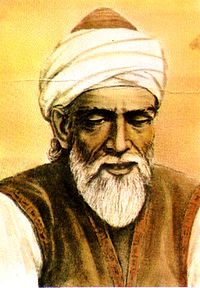Abū al-Wafā'
| Abu al-Wafa' al-Buzjani | |
|---|---|
 |
|
| Born |
June 10, 940 Buzhgan, Iran |
| Died | July 15, 998 CE Baghdad |
| Residence | Baghdad |
| Academic background | |
| Influences | Al-Battani |
| Academic work | |
| Era | Islamic Golden Age |
| Main interests | Mathematics and Astronomy |
| Notable works | Almagest of Abū al-Wafā' |
| Notable ideas | |
| Influenced | Al-Biruni, Abu Nasr Mansur |
Abū al-Wafāʾ, Muḥammad ibn Muḥammad ibn Yaḥyā ibn Ismāʿīl ibn al-ʿAbbās al-Būzjānī or Abū al-Wafā Būzhjānī (Persian: ابوالوفا بوزجانی or بوژگانی) (10 June 940 – 15 July 998) was a Persianmathematician and astronomer who worked in Baghdad. He made important innovations in spherical trigonometry, and his work on arithmetics for businessmen contains the first instance of using negative numbers in a medieval Islamic text.
He is also credited with compiling the tables of sines and tangents at 15 ' intervals. He also introduced the secant and cosecant functions, as well studied the interrelations between the six trigonometric lines associated with an arc. His Almagest was widely read by medieval Arabic astronomers in the centuries after his death. He is known to have written several other books that have not survived.
He was born in Buzhgan, (now Torbat-e Jam) in Khorasan (in today's Iran). At age 19, in 959 AD, he moved to Baghdad and remained there for the next forty years, and died there in 998. He was a contemporary of the distinguished scientists Abū Sahl al-Qūhī and Al-Sijzi who were in Baghdad at the time and others like Abu Nasr ibn Iraq, Abu-Mahmud Khojandi, Kushyar ibn Labban and Al-Biruni. In Baghdad, he received patronage by members of the Buyid court.
...
Wikipedia
